![]()
![]()
![]()
Use LEFT and RIGHT arrow keys to navigate between flashcards;
Use UP and DOWN arrow keys to flip the card;
H to show hint;
A reads text to speech;
48 Cards in this Set
- Front
- Back

CEILING |
A PART OF A BUILDING WHICH ENCLOSES AND IS EXPOSED OVERHEAD IN A ROOM, PROTECTED SHAFT OR CIRCULATION SPACE. - HELP CREATE ENCLOSURE OF AND SEPARATION BETWEEN SPACES, THEY HELP TO CONTROL THE DIFFUSION OF LIGHT AND SOUND AROUND A ROOM, AND HELP PREVENT THE PASSAGE OF SOUND BETWEEN ROOMS. |
|
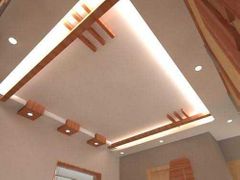
CEILING |
- THEY HAVE FIRE RESISTANT PROPERTIES AND MAY ALSO ACCOMMODATE BUILDING SERVICES SUCH AS VENTS, LIGHTING, SPRINKLER HEADS AND SO ON, AS WELL AS BEING ABLE TO CONCEAL OTHER SERVICES SUCH AS DUCT,PIPES AND WIRING.
|
|

CONVENTIONAL CEILING |
- The conventional ceiling is a standard in most homes. Essentially, it is a wall laid on its side and then covered with a plaster or drywall. There are easy to build and very functional. Conventional ceilings are typically eight feet high, though they can be up to ten feet. Higher ceilings make a room feel larger, but they cost more as you need non-standard construction materials to build them. |
|
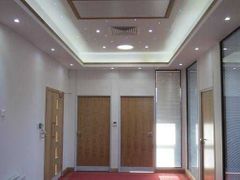
SUSPENDED CEILING |
- A flat ceiling that is underneath an existing ceiling. It has a metal grid suspended from the existing ceiling or from the floor joists from the above floor, and ceiling panels laid into the grid. Often, a suspended ceiling is used for hiding wiring and plumbing that you need easy access to. sometimes referred to as dropped ceilings or false ceilings, are secondary ceilings suspended from the structural floor slab above, creating a void between the underside of the floor slab and the top of the suspended ceiling. |
|

SUSPENDED CEILINGS |
Typically they are hung from a bracket fixed to the underside of the floor slabsupporting a series of interlocking metal sections that form a grid into which panels such as ceiling tiles can be fitted. Beam systems are also available, in which tiles are laid between parallel beams rather than a grid, and there are a wide range of different grid profiles and tile edge details that can be used to allow the grid to be exposed, flush, recessed or concealed. |
|
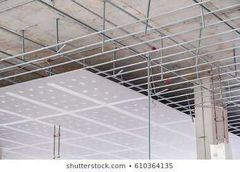
INSTALLING A SUSPENDED CEILING |
A suspended or “dropped” ceiling, consists of a metal grid suspended from joists or the old ceiling and attached at the walls, supporting lightweight ceiling panels. These panels may be made of mineral fiber or fiberglass acoustical board in plain or decorative patterns, or they may be any of several types of translucent plastic panels for above-the-ceiling lighting. |
|

CATHEDRAL CEILINGS |
are high ceilings that are attached directly to the roof trusses. As well as providing the home with an open and spacious feel, they also offer an interesting design to your room. Trusses need to wide enough, at least 12 inches, to have proper insulation and ventilation behind the ceiling. Additionally, because of the height, cathedral ceilings are difficult to paint and change any light fixtures. |
|

VAULTED CEILING |
A ceiling that angles or arches away from the wall. |
|

TRAY CEILING |
A ceiling that is supposed to resemble an upside-down tray. They are often characterized by a flat ceiling with the sides sloping in from the walls to join the ceiling. |
|
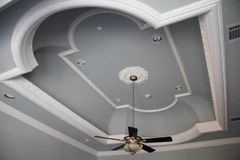
COVE CEILING |
ceilings that have round concave surfaces that connect the wall and ceiling. |
|
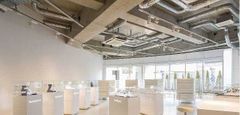
EXPOSED CEILING |
Characterized by the beams, trusses, or system piping left out or exposed. These are often found in older homes. However, it is possible to use fabricated beams and attach them to the ceiling to get the same historic feel. |
|
|
DESIGN OBJECTIVES |
Effective building design requires balancing multiple objectives: aesthetics, acoustics, environmental factors, and integration with the building's infrastructure—not to mention cost of construction as well as long-term operation costs. |
|
|
AESTHETICS |
Drop ceilings may also be used to hide problems, such as structural damage. Further, drop out ceilings can also conceal the sprinkler systems while still providing full fire suppression functionality.Also For many years, dropped ceilings were made of basic white tiles, but modern innovations now offer a plethora of options in sizes, colors, materials (including retro designs and faux leather, wood, or metal), visual effects and shapes, patterns, and textures as well as support systems and ways to access the plenum. |
|
|
ACOUSTICS |
Acoustic balance and control was another early objective of dropped ceilings. A noisy room can overstimulate occupants, while a too quiet interior may seem dull and uninviting.The acoustic performance of suspended ceilings has improved dramatically over the years, with enhanced sound absorption and attenuation. This is sometimes achieved by adding insulation known as Sound Attenuation Batts (SABs), more commonly referred to as "sound batts", above the panels to help deaden sounds and keep adjacent rooms quieter. |
|
|
ENVIRONMENTAL FACTORS |
Indoor environmental quality includes ventilation, VOC emissions, lighting and thermal system control, thermal comfort, use of daylight for natural illumination, acoustics, and optimization of outdoor view availability. A typical dropped ceiling consists of a grid-work of metal channels in the shape of an upside-down "T", suspended on wires from the overhead structure. These channels snap together in a regularly spaced pattern of cells. Each cell is then filled with lightweight ceiling tiles or "panels" which simply drop into the grid. The primary grid types are "Standard 1" (15/16 face), Slimline (9/16" grid), and concealed grid. |
|
|
DISADVANTAGES |
One disadvantage with this ceiling system is reduced headroom. Clearance is required between the grid and any pipes or ductwork above to install the ceiling tiles and light fixtures. Dropped ceilings generally conceal many of the functional and structural elements of a building, creating an aesthetic paradigm that discourages the use of functional building systems as aesthetic design elements. Concealing these elements makes the complexity of today's advanced building technologies more difficult to appreciate. It is also more difficult to perform maintenance on or diagnose problems with the concealed systems.As a renovation tool, dropped ceilings are a quick and inexpensive way to repair a ceiling or reduce HVAC costs. Some materials may show their age quickly— for example, mineral fiber sags, is damaged easily when handled, and stains easily, but stretch ceiling, tin and vinyl do not have these characteristics. |
|
|
CEILING MATERIALS |
There are variety of false ceiling types which are used for home interior. |
|

GYPSUM ( FALSE CEILING ) |
a soft, light weight hydrated sulfate of calcium. Earlier it was very laborious work to install a roof with the traditional methods, but with the advent of gypsum boards for false ceiling, it became easy to install and also cheaper. Gypsum false ceiling consists of gypsum boards that are being supported by iron framework. It is available in variable thickness and sizes as well. It is quite light weight and is easy to install. |
|

METAL ( FALSE CEILING ) |
a very durable material. Besides it has shiny surface. The reflection and its shine add on to its beauty. Metal sheets and plates of different sizes and thickness are available for the purpose of false ceiling. The metals mainly used for false ceiling are Galvanized Iron and Aluminium. Fixing and installation of the metal sheets is quite easy and consumes very less labor. |
|

WOODEN ( FALSE CEILING ) |
a light weight material, also has its own texture and pattern. Wooden false ceiling is used very commonly these days and have a very pleasant impact to the viewers eyes. Hollow wooden blocks, or wooden panels, or wooden boards can be used to make a wooden false ceiling. Wooden blocks can be easily installed even with the help of nails and screws. |
|
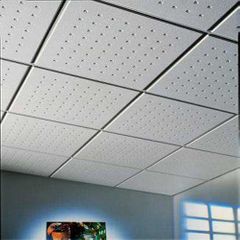
FIBER ( FALSE CEILING ) |
a material developed by man made from natural or synthetic minerals. These when compressed to for a lot, are very good heat insulators as well as sound proofing material. These mineral fiber tiles are available in various shapes, sizes and patterns. These being cheap and quick in installation are in very high demand in the areas of false ceiling buildings. |
|

GLASS ( FALSE CEILING ) |
a non crystalline material. It has a general property of being brittle and transparent, but its properties can be altered by adding metal content and also adhesives to its composition. The glass being used is fiber glass for the purpose of false ceiling. Glass is an insulator and also is a fire retardant material. Glass false ceiling looks great on the ceilings and aesthetically they appear awesome. |
|
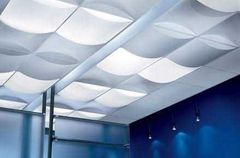
SYNTHETIC LEATHER ( FALSE CEILING ) |
man-made materials being developed to provide aesthetic appearance to the interiors of the building. This type of false ceiling is not extensively used but is very light weight and is quite new. |
|

POP ( FALSE CEILING ) |
Plaster of Paris is commonly used for constructing false ceilings. Gypsum, which gives out water when heated, makes POP. Post-heating, gypsum softens and is then crushed to form a powder. POP hardens instantly when water is added to it. It is applied to fiberboard or a wood base, which is then suspended to form the false ceiling The most important feature of false ceiling’s beauty is cove lighting. It is an indirect form of artificial light. |
|

SKIP TROWEL |
the perfect texture for hiding imperfections on a ceiling. |
|

KNOCK DOWN |
is a mottled texture, more intense than a simple flat finish, but less intense than orange peel, or popcorn, texture. |
|
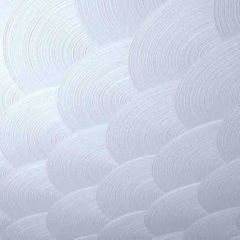
SWIRL |
leaves a swirled pattern of half circles across the ceiling. |
|

LACE |
makes them look similar to exterior stucco. |
|

SPRAY SAND |
have a fine, gritty finish that resembles sand, similar to the look of stucco. |
|

SMOOTH TEXTURE |
have a polished and clean appearance when they're finished properly and don't have any visible seams. |
|
|
LIGHT SOURCES |

F |
|
|
ARTIFICIAL LIGHT |
●MAN MADE LIGHTING. ●FOR HUMAN TO FUNCTION PROPERLY. ●IT CAN BE TURNED OFF AND ON WITH A SWITCH. |
|
|
ARTIFICIAL LIGHT TYPES |

●INCANDESCENT LIGHT ●FLUORESCENT LIGHT ●DISCHARGE LIGHT/ LED LIGHTS |
|
|
INCANDESCENT LIGHT |

●FILAMENT HEATED BY AN ELECTRIC CURRENT PRODUCES LIGHT RAYS ●LESS ENERGY EFFICIENT ●THOMAS ALVA EDISON INVENTED THE FIRST ELECTRIC LIGHT BULBS IN 1879 AD |
|
|
INCANDESCENT LIGHT |
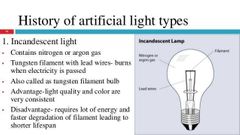
●CONTAINS NITROGEN OR ARGON GAS ●TUNGSTEN FILAMENT WITH LEAD WIRES- BURNS WHEN ELECTRICITY IS PASSED ●ALSO CALLED AS TUNGSTEN FILAMENT BULB ●ADVANTAGE - LIGHT QUALITY AND COLOR ARE VERY CONSISTENT ●DISADVANTAGE - REQUIRES LOT OF ENERGY AND FASTER DEGRAGATION OF FILAMENT LEADING TO SHORTER LIFESPAN |
|
|
FLUORESCENT LIGHTS |

● CONTAINS ARGON/KRPTON AS GAS VAPOR WITH PHOSPER COATING ON THE WALLS OF GLASS TUBE ●ADVANTAGE - COOLER AND MORE ENERGY EFFICIENT THAN INCANDECENT. ●DISADVANTAGE - MERCURY IS DANGEROUS. IF BULB IS BROKEN IT CAN PRESENT HEALTH HAZARDS. |
|
|
DISCHARGE LAMPS |
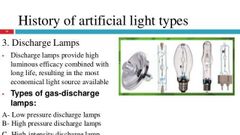
● PROVIDE HIGH LUMINOUS EFFICACY COMBINED WITH LONG LIFE, RESULTING IN THE MOST ECONOMICAL LIGHT SOURCE AVAILABLE. |
|
|
TYPES OF GAS - DISCHARGE LAMPS |

● LOW PRESSURE DISCHARGE LAMPS ● HIGH PRESSURE DISCHARGE LAMPS ● HIGH - INTENSITY DISCHARGE LAMPS |
|
|
LED |
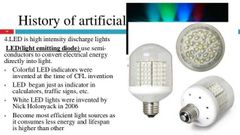
IS HIGH INTENSITY DISCHARGE LIGHTS ( LIGHT EMITTING DIODE ) USE SEMI - CONDUCTORS TO CONVERT ELECTRICAL ENERGY DIRECTLY INTO LIGHT. |
|
|
LED |
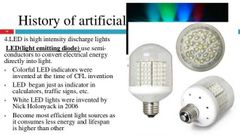
● COLORFUL LED INDICATORS WERE INVENTED AT THE TIME OF CFL INVENTION ●LED BEGAN JUST AS INDICATOR IN CALCULATORS, TRAFFIC SIGNS, ETC. ●WHITE LED LIGHTS WERE INVENTED BY NICK HOLONYACK IN 2006 ●BECOME MOST EFFICIENT LIGHT SOURCES AS IT CONSUMES LESS ENERGY AND LIFESPAN IS HIGHER THAN OTHER |
|
|
AMBIENT LIGHTING |

● KNOWN AS GENERAL LIGHTING. PROVIDES AN AREA WITH OVERALL ILLUMINATION ●IT CAN BRIGHTEN AND ENHANCE THE GLOW OF THE ROOM ●SUCH AS SURFACE AND RECESSED WALL LIGHT AND UPLIGHT |
|
|
TASK LIGHTING |

● HELPS TO PERFORM A TASK SUCH AS READING, COOKING FOOD, INVOLVING IN ANY TYPES OF IMPORTANT TASK ●SHOULD BE FREE OF DISTRACTING GLARES AND SHADOWS ●SUCH AS CFL, TUBE LIGHTS ARE USED |
|
|
ACCENT LIGHTING |

● USED TO HIGHLIGHT THE CERTAIN FEATURES LIKE WALLS AND OBJECT IN THE ROOM ● FOCAL POINT OF THE ROOM WHICH DRAWS ATTENTION OF PEOPLE ENTERING THE ROOM ● SUCH AS CHANDELIERS, PENDANTS, TABLE LAMPS AND SOME WALL LIGHTS ● ALSO CONSIDERED DECORATIVE LIGHTING AS IT ADDS DRAMA AND STYLE BY HIGHLIGHTING KEY OBJECTS AND FOCAL POINTS IN INTERIORS |
|
|
LIGHTING INSIDE SCHOOL AREAS |

●IN SCHOOL BUILDING AREA, NATURAL AND ARTIFICIAL LIGHTS ARE EQUALLY NEEDED ●LEARNING SPACES LIKE CLASSROOMS, LABS, STUDIOS, ETC. USE TYPES FLUORESCENT LAMPS AND LED LIGHTS RATHER THAN INCANDESCENT BULBS |
|
|
LIGHTING INSIDE SCHOOL AREAS |

●IN CLASSROOM AND HALLWAYS GENERAL DOWNLIGHTING CAN BE USED ●IN LABS, ART ROOMS AND SPECIAL AREAS, TASK LIGHTING ARE PREFERRED ●ILLUMINATE TARGET AREAS, SUCH AS WHITE BOARDS, CHALKBOARDS, AND PRESENTATION AREAS. |
|
|
LIGHTING INSIDE HOUSE |
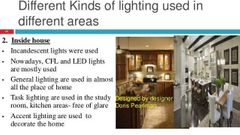
● INCANDESCENT LIGHTS WERE USED ●NOWADAYS, CFL AND LED LIGHTS ARE MOSTLY USED ●GENERAL LIGHTING ARE USED IN ALMOST ALL THE PLACE IN A HOME ● TASK LIGHTING ARE USED IN THE STUDY ROOM, KITCHEN AREAS- FREE OF GLARE ● ACCENT LIGHTING ARE USED TO DECORATE THE HOME |
|
|
LIGHTING INSIDE HOUSE |

● A DECORATIVE CHANDELIER OR HANGING FOYER FIXTURE CAN PROVIDE SIGNIFICANT ILLUMINATION -SERVING AS A BEAUTIFUL FOCAL POINT FOR LIVING AREAS ● GENERAL DOWNLIGHTING ARE AVOIDED AND TASK LIGHTING ARE USED WITHOUT GLARE |
|
|
TYPES OF LIGHTING FIXTURES AND LIGHTING LAYOUTS |

C |

